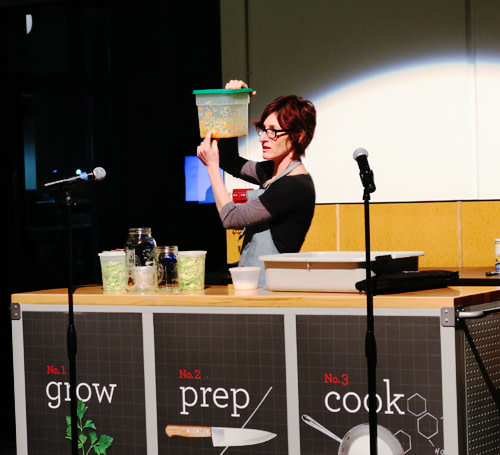A Night of Science and Satisfying Fare

As a casual armchair scientist, I love to know what’s going on behind the scenes—and in the kitchen. If you find yourself tinkering with DIY sous-vide, or simply wish you knew how to make water boil faster, OMSI has a series of dinners that will suit your curious palate.
Check out these food science geekery high points from the latest multi-course OMSI Food Luminary dinner, exploring the divine marriage between science and food through interactive experiments and plenty of great grub.
1. Ice: Shaking and rattling Tupperware bins full of ice, salt, and bags of cream and sugar, diners learned about the effects of salt on water’s state transition points from Hayley Mauck, OMSI’s resident food scientist, and how salt can be smartly employed in the making of ice cream and de-icing roads. (Pro tip: Adding salt to your pasta water will not make it boil faster, so only salt for taste! You would need about 20% salt—blech—in your water to make a difference in boiling time.)
2. Fire: Ignite! Petri dishes full of alcohol and salt solutions glowed brilliant hues of orange and pink as diners learned about potassium iodine, excited electrons, and molecular compounds.
3. Ferment: Salt is a solute, meaning that it absorbs water (a solvent), which is why you get thirsty when you eat a lot of salt. This concept is integral to process of lactic fermentation. Chef Jenn Louis, of Lincoln Restaurant and Sunshine Tavern, demonstrated this concept by layering salt to draw out the water in vegetables, giving them a tangy snap and a crisp finish without too much overpowering vinegar flavor. Fun fact: the word salad comes from the Latin word for “salted”, from the Roman practice of salting leafy vegetables.
4. Salt: One of the five basic tastes that the human tongue can detect, salt enhances the flavor of food. Why? The reasons are many, including allowing certain taste molecules to release into the air, and therefore, your mouth and nose; as well as inhibiting bitter flavors and balancing taste with an additional dimension of flavor. Using a slow distillation process, Oregon's own Jacobsen Salt Co. simmers the waters of Netarts Bay for days, with beautiful, crystalline salt flakes “dancing” their way across the surface until they settle and are collected.
5. Sweet: Salt and sugar play a delicate balancing act. Salt helps to add a bit of dimension to desserts—the salted popcorn panna cotta with vanilla salt Jenn Louis served at the dinner demonstrated this perfectly!
OMSI’s Food Luminary series features a different chef each month at the museum's new Theory Restaurant. Want to get in on the next one? Aaron Barnett of St. Jack will be talking savory science on Friday, March 14, from 6-9 pm. Get your tickets now!




